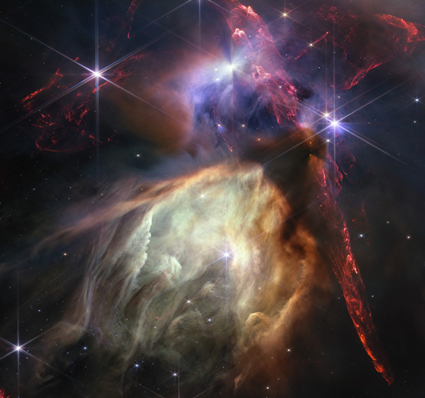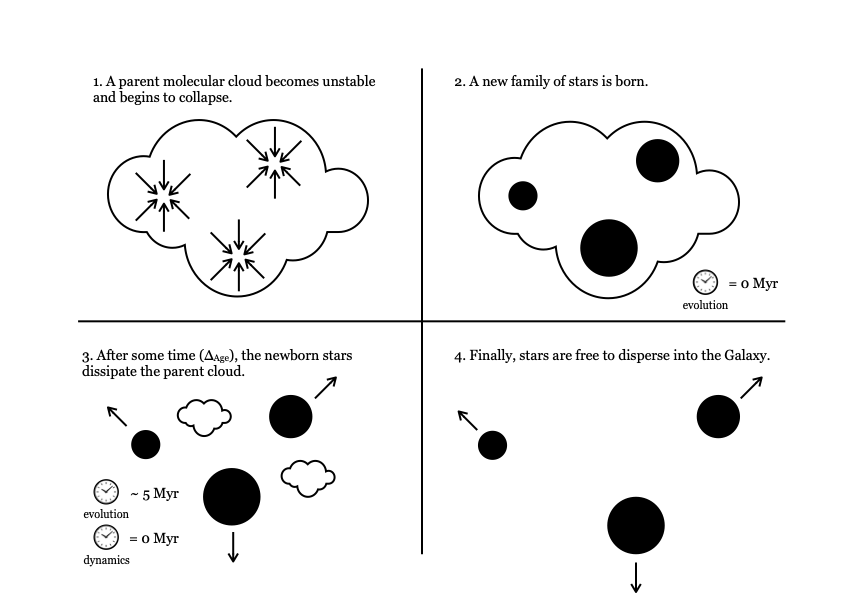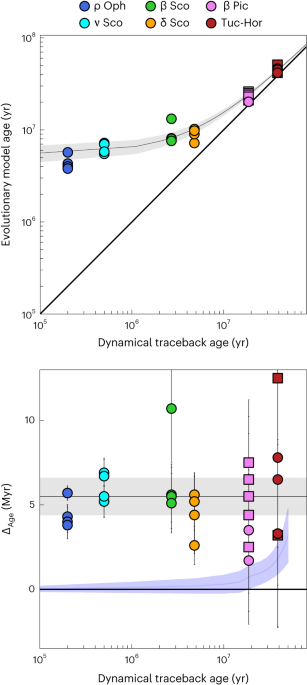Synchronizing stellar clocks reveals new insights into star formation and dispersal
Published in Astronomy

Stellar ages are a fundamental parameter in astrophysics, however, they are one of the hardest measurements to make. The best estimations are for star clusters, i.e. groups of co-eval stars with a common origin. Numerous techniques are used to estimate stellar ages, but they often show conflicting results. Are the age differences between different techniques caused by uncertainties in models and observations? Or, can we profit from this age puzzle to learn something about the star formation process?

Image of the Rho Ophiuchi cloud complex, the closest star-forming region to Earth. This study reveals that the newly born stars in Rho Ophiuchi have not yet begun to drift apart and that the progenitor cloud is still holding them together. Image credit. NASA, ESA, CSA, STScI, Klaus Pontoppidan (STScI).
Astronomers have been using isochronal ages since we understood how stars work, but these ages depend on the particular model we use. The high-quality data from the Gaia satellite complemented with ground-based precise radial velocities allow us, for the first time, to obtain dynamical traceback ages comparable to ages from evolutionary models (e.g. isochrone fitting and lithium evolution). These dynamic ages have the great advantage of being completely independent of evolutionary models, offering a unique opportunity to contrast and test them.
Our work shows a systematic discrepancy between two of the most reliable star 'clocks', i.e. methods to measure stellar ages. We found that dynamical traceback ages are consistently younger by about 5.5 million years than isochrone ages. We got to the point where we can not blame the discrepancy on observational errors anymore, this consistent and puzzling difference is most likely measuring two different things.
We propose that the dynamical traceback 'clock' starts when a star cluster begins to expand after it leaves its parental cloud. In contrast, the isochronal 'clock' starts ticking from the moment of star formation. This result allows us to synchronize the clocks, i.e. to place the two age-dating techniques on the same timeline, and has significant implications for our understanding of star formation and stellar evolution, including planet formation and the formation of galaxies.

Diagram representing the different phases of the formation of star clusters and associations. Ages from evolutionary models measure the time since protostars have accreted most of their final mass and become pre-main sequence stars. Dynamical traceback ages measure the time since the association becomes unbound and starts to expand. The offset between these two techniques (ΔAge) measures the timescale of the embedded phase, during which stars are still bound to the parent gas cloud. Image from Miret-Roig et al. 2023 (https://www.nature.com/articles/s41550-023-02132-4).
This age difference between the two methods constitutes a new and much-needed tool to quantify the earliest stages in a star’s life. It allows us to measure how long baby stars take before leaving their nest. Such a constraint is pivotal in advancing our comprehension of the early life of stars and the evolution of stellar clusters.
In this work, we analyzed a pilot sample of six nearby (<150 pc), and young (<50 Myr) clusters and showed that the timescale of the embedded phase is 5.5±1.1 Myr, and could depend on the cluster mass and amount of stellar feedback. The application of this new technique to other young clusters in the solar neighborhood, where the observational precisions are best, will provide new insights into the star formation and dispersal process. Our work has been possible thanks to the excellent astrometry of the Gaia special mission combined with ground-based radial velocities (such as the ones from the APOGEE catalog), which allow the precisions in the 3D velocities to trace the positions of stars back in time to their birth site. New and coming spectroscopic surveys such as WEAVE, 4MOST, and SDSS-V will make this study possible for the entire solar neighborhood.
Our work paves the way for future research in star formation, offering a clearer picture of how stars and clusters evolve. It's a significant step in understanding the formation of the Milky Way and other galaxies.

Cartoon illustrating the formation of one star cluster. The time when the evolution and dynamical clock start are indicated. Credit: N. Miret-Roig.
Scientific paper: Núria Miret-Roig, João Alves, David Barrado, Andreas Burkert, Sebastian Ratzenböck & Ralf Konietzka, Insights into star formation and dispersal from the synchronisation of stellar clocks, Nature Astronomy (2023). Link.
ACKNOWLEDGEMENTS
Co-funded by the European Union (ERC, ISM-FLOW, 101055318, PI: J. Alves). Views and opinions expressed are, however, those of the author(s) only and do not necessarily reflect those of the European Union or the European Research Council. Neither the European Union nor the granting authority can be held responsible for them.
Proyecto PID2019-107061GB-C61 y No. MDM-2017-0737 financiado por MCIN/ AEI /10.13039/501100011033/ y por FEDER Una manera de hacer Europa
Follow the Topic
-
Nature Astronomy

This journal welcomes research across astronomy, astrophysics and planetary science, with the aim of fostering closer interaction between the researchers in each of these areas.
Related Collections
With Collections, you can get published faster and increase your visibility.
Progress towards the Sustainable Development Goals
Publishing Model: Hybrid
Deadline: Ongoing


Please sign in or register for FREE
If you are a registered user on Research Communities by Springer Nature, please sign in